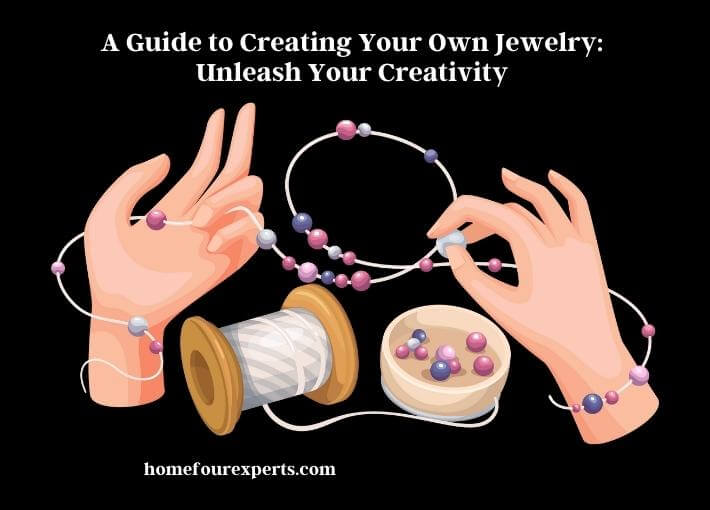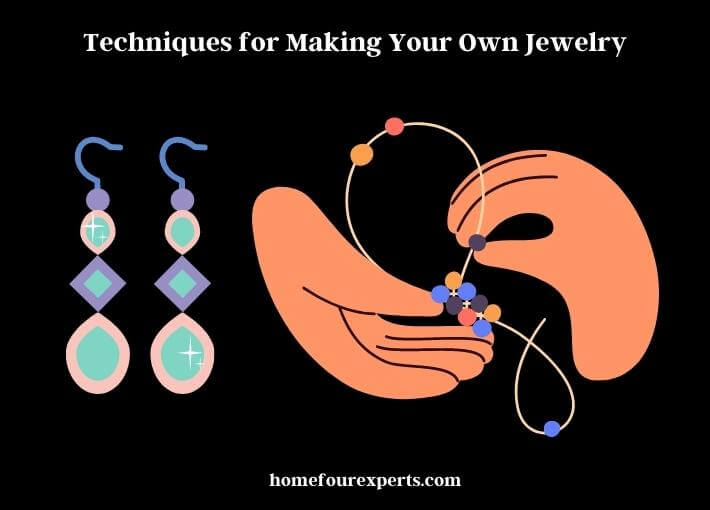Jewelry has been a part of human culture for thousands of years. From ancient times to the modern era, jewelry has always been used as a symbol of status, beauty, and self-expression. Throughout history, people have used various materials such as shells, stones, and precious metals to create jewelry that reflected their personal style and cultural traditions.

While many people still purchase jewelry from stores, creating your own jewelry can be a rewarding and fulfilling experience. Making your own jewelry allows you to express your creativity and individuality, and gives you the opportunity to create unique pieces that reflect your personal style.
Making your own jewelry can be a great way to relax and unwind. It provides a creative outlet and a way to focus your energy on something positive and productive. Whether you’re looking to make a special gift for someone, create a piece of jewelry to wear yourself, or just try out a new hobby, making your own jewelry can be a fun and fulfilling experience.
Materials Needed for Jewelry Making
When it comes to creating your own jewelry, there are many materials and tools you will need. Here are some of the most common materials and tools used in jewelry making:
Beads – Beads are perhaps the most common material used in jewelry making. They come in a variety of materials, shapes, and sizes, and can be used to create a wide range of jewelry pieces.
Wire – Wire is used to create the structure of many jewelry pieces. It comes in different gauges and materials, such as copper, silver, and gold.
Pliers – Pliers are essential tools for jewelry making. They are used for bending and shaping wire, opening, and closing jump rings, and attaching findings.
Findings – Findings are the clasps, ear wires, and other components that are used to finish off a piece of jewelry. They come in a variety of materials and styles to suit different types of jewelry.

Stringing materials – Stringing materials such as beading wire, cord, and thread are used to string beads and other components together.
Charms and pendants – Charms and pendants are decorative elements that can be added to a piece of jewelry to give it a personalized touch.
Tools – Other tools that are useful in jewelry making include wire cutters, round nose pliers, crimping pliers, and a bead mat to keep your materials organized.
By having these materials and tools on hand, you will be able to create a wide range of jewelry pieces and let your creativity soar.
Choosing Your Design and Style
Choosing a design and style is an important part of creating your own jewelry. There are many different styles and designs to choose from, ranging from simple and elegant to bold and colorful. Here are some tips for choosing your design and style:
- Consider your personal style – The jewelry you create should reflect your personal style and taste. Think about the colors, textures, and materials you are drawn to when choosing your design.
- Look for inspiration – There are many sources of inspiration for jewelry making, such as fashion magazines, Pinterest, and Instagram. Look for jewelry designs that catch your eye and try to incorporate similar elements into your own creations.
- Start simple – If you are new to jewelry making, start with simple designs that are easy to create. As you gain experience and confidence, you can begin to experiment with more complex designs.
- Choose the right materials – The materials you choose will have a big impact on the overall style of your jewelry. Consider the color, texture, and weight of the materials you use, and how they will work together to create your desired look.
- Think about the occasion – Consider where and when you will be wearing the jewelry you create. For example, if you are creating a piece for a formal occasion, you may want to choose materials that are more elegant and understated.
- Experiment with different styles – Don’t be afraid to experiment with different styles and designs. You may discover new techniques or combinations of materials that you love and that become a signature style for your jewelry creations.

By considering these factors and following your intuition, you can create jewelry pieces that are uniquely your own and that reflect your personal style and creativity.
Techniques for Making Your Own Jewelry
There are many techniques involved in making your own jewelry. Here are some of the most common techniques used in jewelry making:
Beading
Beading is the process of stringing beads together to create a jewelry piece. This technique can involve using a variety of beads, from small seed beads to larger gemstones, and can be used to create necklaces, bracelets, and earrings.
Wire Wrapping
Wire wrapping involves using wire to create the structure of a piece of jewelry, such as a pendant or a pair of earrings. This technique can be used to create intricate designs and can be combined with other techniques such as beading to create unique pieces.
Metalworking
Metalworking involves shaping and manipulating metal to create jewelry pieces. This technique can involve using a variety of tools, from hammers and anvils to soldering equipment, and can be used to create rings, bracelets, and other metal jewelry pieces.
Knotting
Knotting involves tying knots in stringing materials such as cord or thread to create a jewelry piece. This technique is often used in creating knotted pearl necklaces or bracelets.

Polymer Clay
Polymer clay is a type of clay that can be molded and shaped into various designs and then baked to harden. This technique can be used to create unique and colorful jewelry pieces, such as earrings, pendants, and beads.
Resin
Resin is a material that can be mixed with dyes or other materials to create unique designs. This technique can be used to create jewelry pieces such as pendants, earrings, and bracelets.
Chainmaille
Chainmaille involves weaving metal rings together to create a variety of patterns and designs. This technique can be used to create unique and intricate jewelry pieces, such as bracelets and necklaces.
Adding Finishing Touches to Your Jewelry
Adding finishing touches to your jewelry can make all the difference in creating a polished and professional-looking piece. Here are some techniques for adding those final touches:
Polishing – Polishing your jewelry can help bring out the shine and luster of your materials, whether they be metal or gemstones. Use a polishing cloth or a polishing machine to buff your jewelry to a shine.
Clasps and findings – Choosing the right clasps and findings can add to the overall look of your jewelry piece. There are many types of clasps and findings to choose from, such as lobster clasps, toggle clasps, and jump rings.
Crimping – Crimping involves using a small metal tube to secure the ends of a necklace or bracelet. This technique creates a clean and secure finish to your jewelry piece.
Adding embellishments – Adding small embellishments, such as beads or charms, can add interest and detail to your jewelry piece. Choose embellishments that complement the overall design and style of your jewelry.
Wire wrapping – Wire wrapping can also be used as a finishing technique to add details and accents to your jewelry piece. For example, you can wire-wrap a small gemstone or bead onto a chain to create a unique accent.
Enameling – Enameling involves applying colored enamel to metal jewelry components to add color and interest. This technique can be used to add a pop of color to your jewelry piece or to create a more intricate design.
By using these techniques and adding your own personal touches, you can create jewelry pieces that are not only beautiful but also professional-looking and high-quality.
Tips for Caring for Your Homemade Jewelry
Caring for your homemade jewelry is important to ensure it stays looking its best and lasts for a long time. Here are some tips for caring for your homemade jewelry:
- Store your jewelry properly – Store your jewelry in a cool, dry place to prevent damage from moisture and humidity. You can also use anti-tarnish strips or a jewelry box lined with anti-tarnish fabric to help prevent tarnishing.
- Clean your jewelry regularly – Clean your jewelry regularly using a soft cloth and a mild soap and water solution. Avoid using harsh chemicals or abrasive cleaners, which can damage your jewelry.
- Avoid exposing your jewelry to harsh chemicals – Avoid exposing your jewelry to chemicals such as perfumes, hairspray, and cleaning products, as they can damage your jewelry and cause discoloration.
- Remove your jewelry before swimming or showering – Remove your jewelry before swimming or showering, as chlorine and other chemicals can damage your jewelry and cause it to tarnish.
- Handle your jewelry with care – Be gentle when handling your jewelry, as it can be fragile and delicate. Avoid tugging or pulling on chains or wires, as this can cause them to weaken or break.
- Have your jewelry inspected and repaired regularly – Have your jewelry inspected by a professional jeweler regularly to ensure it is in good condition and to catch any damage before it becomes worse. They can also repair any damage or make adjustments as needed.
By following these tips, you can keep your homemade jewelry looking beautiful and in good condition for years to come.
FAQs
How Can I Get Started With Making My Own Jewelry?
To get started with making your own jewelry, you’ll need to gather some basic tools and materials, choose a design and style, and learn some basic techniques. There are many tutorials and resources available online or you can take a class at a local craft store or community center.
What Are Some Common Materials Used in Jewelry Making?
Some common materials used in jewelry making include beads, wire, metal, gemstones, and leather. The specific materials you choose will depend on your design and style preferences.
How Can I Add a Personal Touch to My Homemade Jewelry?
You can add a personal touch to your homemade jewelry by choosing materials and designs that reflect your personal style or interests. You can also add small details or embellishments, such as charms or initials, to make the piece uniquely yours.
How Do I Care for My Homemade Jewelry?
To care for your homemade jewelry, store it properly, clean it regularly, avoid exposing it to harsh chemicals, handle it with care, and have it inspected and repaired by a professional jeweler as needed.
Can I Sell My Homemade Jewelry?
Yes, you can sell your homemade jewelry online or at local craft fairs or markets. However, be sure to research any necessary licenses or permits required in your area and ensure that your jewelry meets any applicable safety or quality standards.
The Bottom Line
Creating your own jewelry can be a fun and rewarding hobby that allows you to express your creativity and individuality. With the right tools, materials, and techniques, you can create beautiful and unique pieces that reflect your personal style and taste.
Remember to take your time, experiment with different designs and styles, and don’t be afraid to make mistakes. With practice and patience, you can become a skilled jewelry maker and create pieces that you will cherish for years to come. And don’t forget to care for your homemade jewelry properly to ensure it stays looking its best. So, unleash your creativity and start making your own jewelry today!
If you want to know to elevate your home decor with wine bottle vases, see here for details.
About This Writer

Guys, I am Camila Avery and I love to help my mom to do indoor & outdoor activities. As a lady, I have passed my time on gardening, home improvement, and personal or self-care. I have acquired some degrees in outdoor recreation, beauty, and hair care. It is not easy to work with top-level professional beauty experts. But, I got that opportunity and experimented with different hair extensions, hair colors, and cuts.